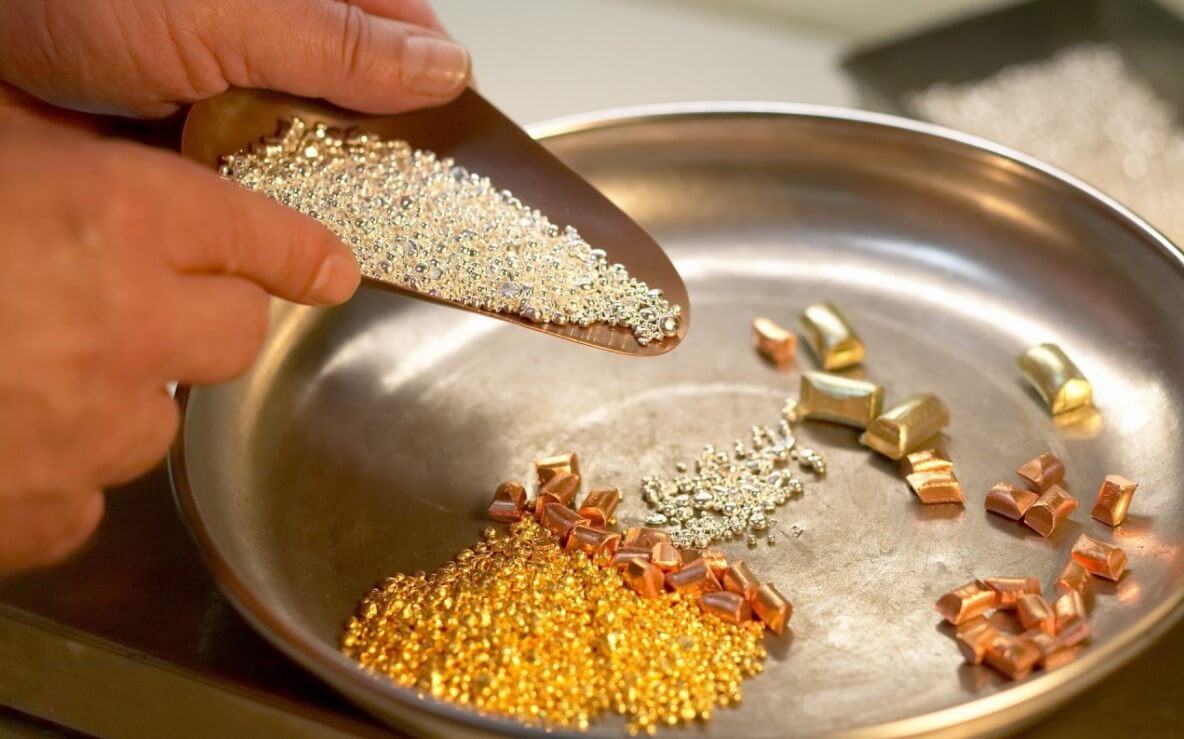Metals can make a great addition to any trader’s portfolio, so long as one understands the risks and rewards related to trading this type of instrument. Combining that knowledge with careful trading decisions can certainly pay off for savvy investors. Most Forex brokers offer investment opportunities in Gold and Silver, while Platinum, Palladium, and Copper are also commonly traded metals. In this guide, we will cover the unique aspects related to each of these metals, along with other base metals, and what drives their prices.
Gold
Gold has earned its spot as the most popular trading metal because of its several unique qualities:
- It can be used as currency
- Jewelry
- Industrial uses (dentistry and electronics)
- Durability
- Conducts heat & electricity
Supply & demand does not have as much of an effect on Gold, which helps the metal to retain its value. People tend to hoard it because of financial concerns related to the economy, in relation to inflation, and when a political crisis is on the horizon. However, this works out, as the price drops when the hoarded Gold is sold, and prices are driven higher when others want to buy. In 1980, Gold reached its highest price of $2,076. Since then, the price has gone up and down several times.
Silver
Silver is typically offered alongside Gold and is one of the most well-known trading metals. Silver’s price can be more volatile than Gold, but it does have several important applications:
- Currency
- Photography
- Batteries
- Electrical Appliances
- Medical Products
- Industrial Items that require Silver inputs
The demand for Silver in both industrial and investment areas can cause the price to go in either direction, which is the main reason for its higher volatility. As a precious metal, silver holds its value better than printed money.
Platinum
Platinum is an industrial metal with many practical uses in:
- The Auto Industry
- Jewelry
- Petroleum
- The Computer Industry
This precious metal is rarer than Gold since less of it is removed from the ground yearly. South Africa is one of the main sources for the supply of Platinum. The rarity of Platinum drives the price up, making it one of the most volatile metals to trade. It also finds itself listed as an amount in a broker’s investment portfolios less often than the ever-popular Gold & Silver.
Palladium
Palladium is a lesser-known precious metal with several industrial uses:
- Manufacturing; electronics & industrial products
- Dentistry
- Medicine
- Jewelry
- Chemical Applications
- Groundwater Treatment
Palladium is considered more of a luxury metal in some instances, yet it is also essential for preventing air pollution. Like Silver and Platinum, the price of Palladium is more volatile, making it a risky but potentially rewarding investment option.
Copper
Although Copper is the most inexpensive of the items on our list (and the only option that isn’t considered to be a precious metal), it is still useful in the production of several items:
- Motors
- Generators
- Wiring
- Machinery
Copper is one of the five most-traded commodities and it also experiences high volatility.
In addition to the above options, some brokerages also offer trading in the following base metals:
- Aluminum: This lightweight, recyclable, and corrosion-resistant metal has many industrial uses and a strong demand in China.
- Iron: Iron is used to manufacture steel, in engineering, and to make alloy steels, which help to build bridges, electricity pylons, bicycle chains, cutting tools, and rifle barrels.
- Lead: Lead is used in battery production, x-rays, piping, and for many other industrial needs. China is the leading country in the production of the metal.
- Steel: Steel is valuable for construction and engineering purposes.
- Nickel: As one of the most widely used metals on Earth, Nickel has many favorable traits that make it useful for industrial purposes. Stainless steel, electronics, plating, catalysts, and rechargeable batteries are all made using Nickel.
- Zinc: Galvanizing metal, alloys, die-castings, zinc-oxide (cosmetics, paint, pharmaceuticals, rubber, plastics, ink, batteries, etc.), and zinc-sulfide are the main uses of Zinc. The price is driven by Chinese supply & demand, US demand, global prices, and input prices.
- Tin: Tin is often used as a protective coating due to its high resistance against corrosion. Soldering demand is one of the top factors driving the price of Tin.
- Molybdenum: This metallic element has a high melting point, making it a strong compound in alloys like steel. The price is driven by supply & demand, global stocks, demand outlook, seasonal changes, and input prices.
Risks & Rewards
Supply & demand is one of the main issues that can affect the price of a metal. During times of economic uncertainty, many traders gravitate towards metals, which can cause the price to shoot up. This could ultimately affect one’s ability to find a buyer.
On the other hand, adding metals to one’s investment portfolio lowers the overall risk of volatility and risk. This is because they have intrinsic value, which protects against inflation. Unlike with money, it is impossible to print more Gold, Silver, Platinum, etc., which makes metal a more stable investment option. Gold, Silver, and Platinum are among the top-traded commodities, next to Crude Oil and Natural Gas. Long-term trends also secure the value of these metals, including demand from China, technological innovations, and environmental regulation.

